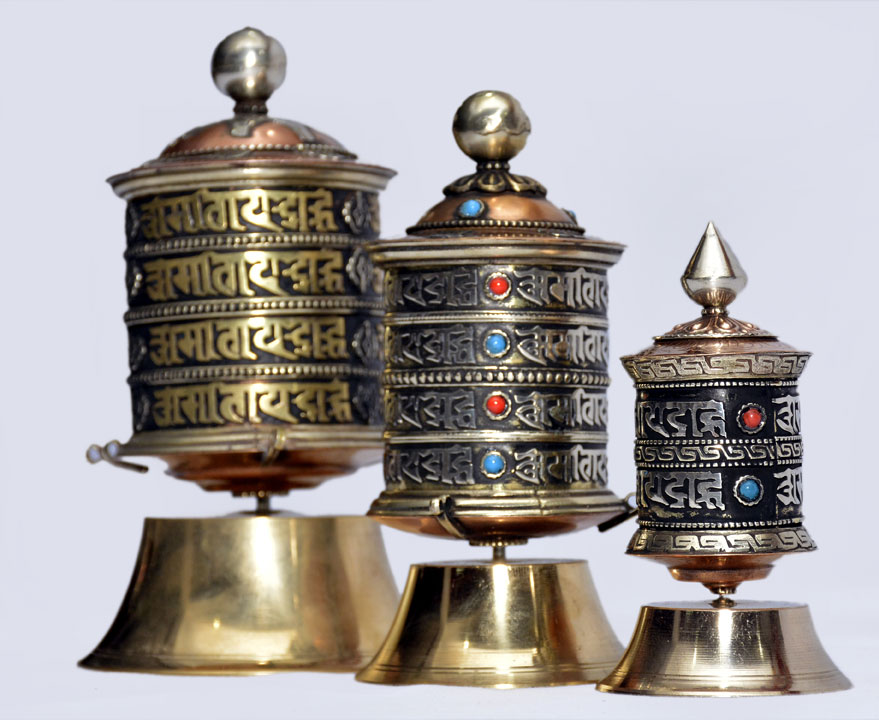Style
Tibetan Prayer Wheel
In the high mountains of Tibet, where prayer flags flutter in the wind and monasteries cling to cliffs, the gentle rhythm of spinning prayer wheels is a sacred sound. Known in Tibetan as Mani wheels, these sacred objects hold profound spiritual significance in Buddhism, particularly in the practice of compassion and devotion. More than just ritual objects, Tibetan prayer wheels are moving symbols of faith, meditation, and the aspiration for peace.
What is a Tibetan Prayer Wheel?
A Tibetan prayer wheel is a cylindrical wheel mounted on a spindle, traditionally inscribed with or filled with thousands of copies of the mantra “Om Mani Padme Hum.” This mantra, dedicated to Avalokiteshvara (the Bodhisattva of Compassion), is believed to generate immeasurable spiritual merit when recited—or in this case—spun.
Prayer wheels come in many sizes and forms:
-
Hand-held wheels small enough to carry.
-
Large standing wheels found in monasteries, often turned by devotees as they circumambulate.
-
Water-powered wheels placed in rivers so that the flowing water itself is believed to carry prayers across the land.
The Meaning Behind the Spin
At the heart of the prayer wheel is a beautiful teaching: spinning the wheel is as powerful as reciting the mantra verbally. Each rotation is said to multiply the prayers contained within the wheel, radiating blessings and positive energy to all beings.
-
Spiritual Merit: Every turn is believed to purify negative karma.
-
Compassion in Action: The prayers are not only for oneself but for the well-being of all living beings.
-
Mindful Meditation: The act of turning the wheel becomes a meditative practice, focusing the mind and connecting body and spirit.
This reflects the core of Buddhist philosophy—intent matters as much as action.
Origins and History
The origins of the prayer wheel can be traced back to ancient India, where Buddhist monks first used written mantras as aids to meditation. The practice later spread to Tibet around the 4th century, evolving into the unique form we see today. Tibetan artisans began crafting wheels from wood, copper, silver, and even gold, each one decorated with sacred symbols like the lotus flower or the eight auspicious symbols of Buddhism.
Over centuries, prayer wheels became integral to Tibetan life. Pilgrims traveling long distances often carried hand-held wheels, spinning them continuously as they walked. In monasteries, monks turned massive wheels during ceremonies, their chants resonating alongside the soft hum of the spinning cylinder.
The Mantra: Om Mani Padme Hum
At the heart of every prayer wheel lies this six-syllable mantra. Each syllable carries profound meaning:
-
Om – Purifies pride/ego
-
Ma – Purifies jealousy and lust
-
Ni – Purifies passion and desire
-
Pad – Purifies ignorance and prejudice
-
Me – Purifies greed and possessiveness
-
Hum – Purifies hatred and aggression
Together, these syllables embody the essence of compassion, wisdom, and enlightenment. With every spin, the mantra is believed to echo across the universe.
Symbolism in Everyday Life
Beyond monasteries and pilgrim paths, Tibetan prayer wheels symbolize hope and resilience. For many Tibetans, spinning a wheel before beginning daily work or travel is a way of seeking blessings for safety and success. Families often keep small prayer wheels at home, teaching children to spin them as a daily act of devotion.
Prayer wheels also embody the Buddhist teaching of interconnectedness. Just as one spin radiates prayers outward, our actions—kind or unkind—ripple into the world around us.
Modern Adaptations
Today, Tibetan prayer wheels are not confined to the Himalayas. They can be found in Buddhist centers, temples, and even homes around the world. Some modern designs include:
-
Digital prayer wheels that rotate electronically.
-
Miniature wearable wheels as jewelry for constant mindfulness.
-
Artistic adaptations blending traditional craft with modern aesthetics.
These innovations show that while the form evolves, the essence remains unchanged: to cultivate compassion and spread peace.
How to Use a Prayer Wheel
Using a prayer wheel is simple yet sacred:
-
Hold the wheel upright, usually in the right hand.
-
Rotate it clockwise, in harmony with the movement of the sun across the sky.
-
Focus on the mantra Om Mani Padme Hum while spinning.
-
Dedicate the merit of your practice to all sentient beings.
Many practitioners accompany the motion with deep breathing, turning it into a moving meditation.
The Deeper Lesson
While the prayer wheel is a physical object, its true teaching lies beyond form. It reminds us that every small action—just like each spin—can create ripples of compassion. Even the simplest daily practices, done with mindfulness and good intention, can have cosmic significance.
Conclusion
The Tibetan prayer wheel is more than a ritual object; it is a living symbol of compassion in motion. Whether found in a remote mountain monastery or in a modern meditation space, its steady rhythm carries a universal message: peace, compassion, and interconnectedness.
In a world often spinning with chaos, the Tibetan prayer wheel invites us to spin with intention—sending out love, harmony, and blessings with every turn.

